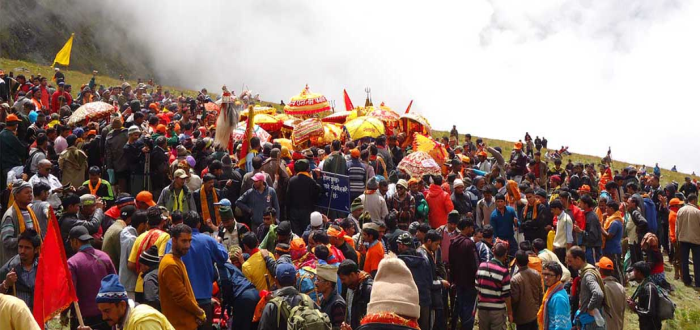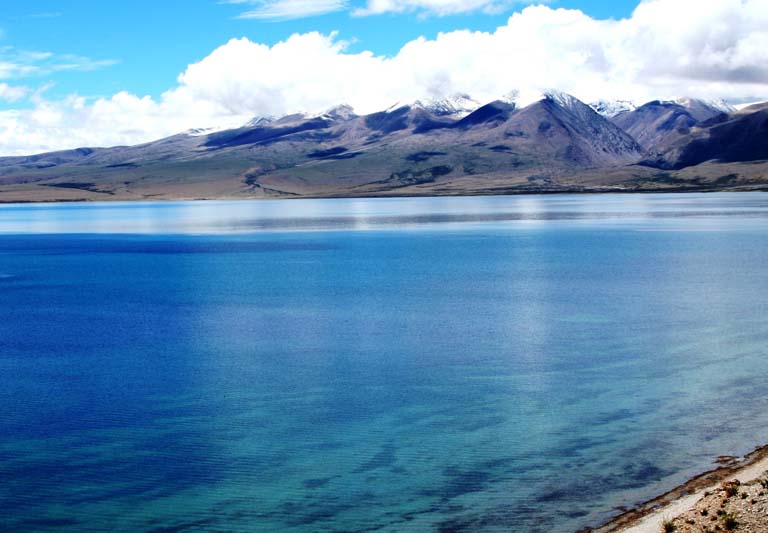Did You Know?
- Mount Kailas and Lake Manasarovar are situated in Tibet (now a part of China).
- Kailas-Manasarovar region is in the north of Himalayas and consists of the twin lakes- Manasarovar (lake of Mind) and Rakshas Tal (Devil’s lake).
- Hindus speak of Mount Kailas as Siva’s throne who sits with his consorts Goddess Parvati. Indian scriptures tell that Mount Kailas is approachable by us mortals as it is on planet earth. While abodes of other Trinity i.e. Lord Brahma (Brahmalok) and Lord Vishnu (Vaikunth or Vishnulok) lay in heaven and are unapproachable by human beings.
- From the centre of paradise of the world, (Kailas and Manasarovar region) four rivers also originate – geographically forming a watershed where cosmic geometric energy pervades. From the East originates Langchen Khambab which means ‘Elephant mouth’ or river Sutlej (Shatadru),while from west, Senge Khambab, River from the Lion’s mouth or Indus (Sindhu), From the north, Mapchu Khambab (River from the mouth of a Peacock) or say Karnali and from the south originates Tamchok Khambab (River from Horse’s mouth) or Brahmaputra (Lolita). All rivers exhausts into Bay of Bengal and Arabian Sea while travelling hundreds of kilometers through different regions of Central Asia.

- The year 2014 was the year of ‘Horse’ according to Tibetan system. Horse year is very auspicious year to perform Kora. Horse year comes after every 12 years and next Horse year will take place in 2026. This year long astronomical event is known as ‘The Great Horse Festival’ at Mount Kailas and starts from ‘Saga Dewa’ festival. According to Kalachakra Tantra, Godsang Gonpo introduced the system of Kora.
- The Kora path begins from Darchen. Between Darchen and Tarboche, looking left in south-west direction is twin, sharp humps of Mount Kamet (7756m) in India. Mount Nanda Devi is close to Mt. Kamet. Nanda Devi is an avatar (reincarnation) of Goddess Parvati. She is worshipped as daughter of Himalayas and consort of Lord Siva.

Nanda Devi Raj Jat yatra or Himalayan Kumbh was also organized in 2014 in Horse year. It is celebrated as ‘Bidai’ (farewell) of Goddess Nanda Devi in the form of Parvati from her maternal home Nauti in Himalayas to her husband’s home (Mount Kailas).
 A four-horned sheep which becomes the seat of the idol of Goddess Nanda Devi decorated with ornaments, food, clothing and other offering is escorted in a 19 days procession till Homkund (17500 ft.) in Mount Nanda Devi region. It is assumed that the sheep in the form of Goddess Parvati goes to meet Lord Siva at Mount Kailas.
A four-horned sheep which becomes the seat of the idol of Goddess Nanda Devi decorated with ornaments, food, clothing and other offering is escorted in a 19 days procession till Homkund (17500 ft.) in Mount Nanda Devi region. It is assumed that the sheep in the form of Goddess Parvati goes to meet Lord Siva at Mount Kailas. - The legend of the source of the river Ganges descending from heaven to Mount Meru or Kailas turns out to be a myth. The river flowing from Meru is Darchung or Uma which merges in Rakshas Tal. River Bhagirathi and Alaknanda are often cited as Ganges. Its origin is from Gaumukh near Gangotri in Uttarakhand. However, the origin of the Ganges River is in close proximity to river Karnali which is one of the Gange’s main tributaries originating from Tibet. River Karnali originates from the south of the Rakshas Tal and flows south-east of Mount Gurla Mandhata. It touches Purang (Taklakot) alongwith all the tributaries originating from Gurla Mandhata. From Purang, river Karnali moves to Khojernath (last destination in Tibet) and flows into north- west of Nepal. There it converges with other tributaries of the river Karnali and enters India. In India, It is called River Ghaghra and merges with Ganges at Patna. We cannot trace the origin of Ganges nor can we find any obvious connection between the Ganges and Kailas as per Puranic accounts but of course Ganga remains Mother Ganga. Hindu worship Ganga as holy Goddess and its greatness is unparallel to other rivers.

